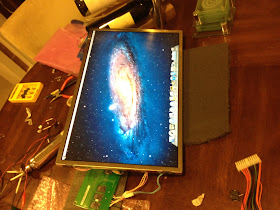I believed that the LCD itself would not pose a problem and I posted the TMDS to DVI pinout in this post, though had not been able to confirm it until now. And yes it does work.
 |
| The Apple Logo on the ID Tech 20" Panel |
When I finished my 17" STEP by STEP GUIDE. I knew I was going to get questions regarding to 20" and if such an easy approach could be used. However, because of my cinema display mod, I now had information about the inverter that I had previously lacked. I have never owned a working 20" iMac G4 and was therefore making (supposedly) educated guesses, while trying to figure out the inverter. A damaged inverter later, I realized this approach was not great. With a working inverter via the cinema display's controller, I finally had voltages to check and use as a guide.
So, using my new technique, once the pins were free (The LCD was wired up in just a few minutes). I then tried a few different things using my new information. And for the first time I had a 20" iMac G4's native LCD and inverter display a backlit video signal through the neck (hooked up to a mac mini via DVI) using only wires, connectors and power supplies. The power scheme is much more complex than the 17", this is due to the higher power requirements of the 20" LCD. However, this uses the same method for the LCD as the 17" mod and is quite reproducible.
For those who have followed this blog, you know that this has always been a frustrating shortcoming for me. It has been a long time, but I am so excited to be able to share this with everyone.
 |
| Lion's Desktop |
 |
| Identified Monitor as "iMac" |
Again, thanks for reading!


Great news & thank you J
ReplyDeleteThanks! Believe me it's been a long time coming. This uses a 24V incoming line that splits to power both the high voltage lines of the inverter as well as a Pico PSU that gives me my molex connector. I designed it this way as it can now power any atx compatible motherboard. However, although it is convenient to have only one power source/plug, the disadvantage is that I would need to have a 24V power source (at least 3 amps) with enough watts to power not only the lcd (inverter and all), but the motherboard and the drive. Worst case scenario, you could have seperate lines for the LCD and motherboard and still use the LCDs line to power peripherals (ex drives).
ReplyDeleteJBerg,
ReplyDeleteCongratulations! I agree that using that 24V power source is a good, but not the desired solution. You should really think about the LED conversion. My last two 20" Cinema Display conversions were really successful. Lately I found a (of course time-consuming) method, which results in a perfect brightness. Together with my small controller it even conserves the USB brightness control for those monitors. Advantage: Only a third power consumption than before and - 12V input!
Best Wishes
JL7
Hey JL7, thank you and I completely agree. The 24V line makes this much more of a pain. And I still have to figure out the wattage requirements that an all in one setup + LCD + inverter I'll require. What I'm using here is an AC to 24v DC power brick that powers a pico PSU that supports 24V DC input. The downside is that a "high wattage" 24v output power brick is harder to come by and more expensive than a 12v output. (I know of one - but it's pricey). Obviously splitting the power of the display and internal computer can be done, but 2 power bricks and AC plugs is not a very "elegant" solution.
ReplyDeleteIt's funny, had they continued to make 20" 16:10 monitors, I would have used the LED backlighting from an off the shelf monitor and been done with an iMac G4 mod that improves upon the original over a year ago. Your solution and mods are quite brilliant and LED backlighting this mod would be great. But, it requires a great amount of technical skill - I can't wait to try it myself, but am worried that I may have difficulty putting it together.
I was wondering if you had any experience with DC-DC upconverters. I am trying to make as cheap and simple a solution as possible. Am i missing any other way to get a stable 24v line? Any advise or recommendations are appreciated. Thanks Again, JB
JL - As I'm putting together the new 20" I think you are right and that this is the time to try LED backlighting. Your cinema display mod is fantastic and I'm nearly certain I can use the same (or slight) PWM that you designed. I was hoping if I could get your advice and recommendations. With the "folding" method, how much LED ribbon did you end up using? How do you handle on/off and sleep? Did you choose bright white? How many lumens was your ribbon? Thanks again and I hope I can do 1/10th as beautiful a job as you did.
ReplyDeleteKineMaster for pc
ReplyDeleteKineMaster for mac
KineMaster without watermark
KineMaster chroma key
KineMaster old version
KineMaster for pc download
Kinemaster whatsapp status video
KineMaster video layer